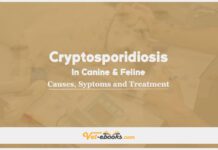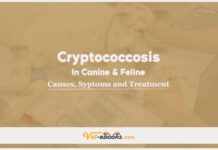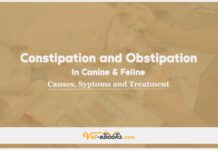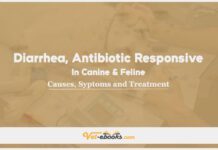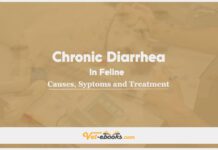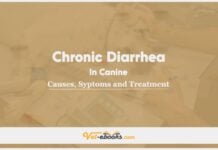Coccidioidomycosis In Canine and Feline: Causes, Symptoms and Treatment
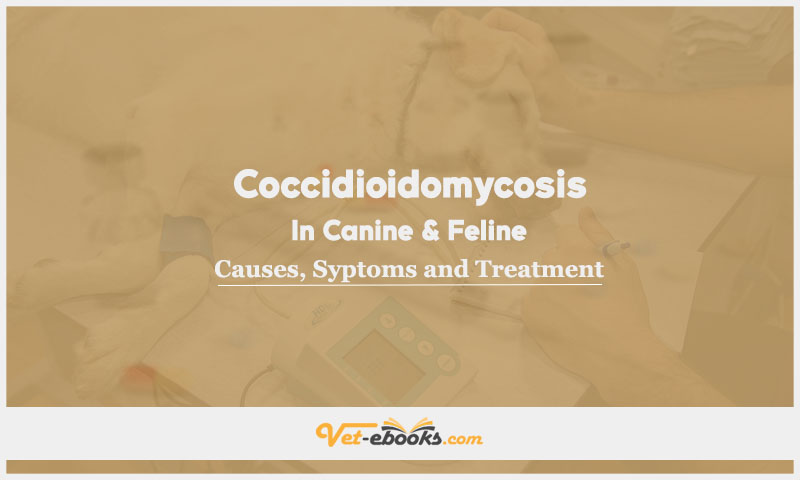
Overview
Coccidioidomycosis is a systemic fungal infection that occurs when individuals inhale infectious arthroconidia released by the soil-dwelling fungus known as Coccidioides immitis.
Causes of Coccidioidomycosis In Canine and Feline
Causes
Coccidioides Immitis, How it causes the disease:
- C. immitis resides several inches deep in soil and withstands high temperatures and low moisture levels.
- After rainfall, it emerges from the soil and begins sporulation.
- Numerous arthroconidia are released then they disperse through wind and dust storms.
Risk factors
- Aggressive foraging in contaminated soil and dense underbrush.
- Dust storms, often occurring after the rainy season, can further increase the risk of exposure to these infectious particles.
- Land development activities that involve soil disruption .
Pathogenesis of Coccidioidomycosis In Canine and Feline
- It grows in the soil in the mycelial state.
- The primary mode of infection is through the inhalation of infective arthroconidia.
- Respiratory symptoms typically manifest 1–3 weeks after exposure, while signs of dissemination might not become apparent for several months.
- Most infections tend to be mild or subclinical, although dogs are generally more susceptible than cats to developing disseminated disease.
- Clinical symptoms such as fever, lethargy, loss of appetite, coughing, and joint pain or stiffness may become noticeable.
- Dissemination can occur within as little as 10 days, leading to symptoms linked to the affected organ system, with skin lesions often associated with dissemination.
Symptoms (History & Physical Examination) of Coccidioidomycosis In Canine and Feline
History
This disease is relatively rare, primarily occurring in endemic areas. Endemic regions are mainly found in the southwestern United States within the geographic Lower Sonoran Life Zone, including Southern California, Arizona, and southwest Texas, with lower prevalence in New Mexico, Nevada, and Utah. Historically, symptoms have included anorexia, persistent cough, fever that doesn’t respond to antibiotics, lameness, weakness leading to paraparesis, back and neck pain, seizures, changes in vision, and unexplained weight loss.
Physical Examination
Dogs :
- Pulmonary symptoms include cough, difficulty breathing (dyspnea), and fever.
- Disseminated disease is marked by symptoms like bone swelling, joint enlargement, lameness, overall physical decline (cachexia), lethargy, and swollen lymph nodes (lymphadenopathy).
- Neurological signs may encompass both central and peripheral deficits.
- Skin ulcers may appear, accompanied by draining tracts.
- Ocular symptoms can include uveitis, keratitis, iritis, and retinitis
Cats :
- Wasting syndrome (Cachexia)
- Skin lesions with discharge (Draining skin lesions)
- Difficulty breathing (Dyspnea)
- Limping resulting from bone participation (Lameness caused by bone involvement)
- Inflammation of the uvea in the eye (Uveitis)
Diagnosis of Coccidioidomycosis In Canine and Feline
1- From History and Physical Examination
2- Diagnostic Procedures
CBC/BIOCHEMISTRY/URINALYSIS :
- Hemogram findings may include a slight non-regenerative anemia, an increase in neutrophils (neutrophilic leukocytosis), and elevated levels of monocytes (monocytosis).
- In the serum chemistry profile, you may observe high levels of globulins (hyperglobulinemia), reduced albumin levels (hypoalbuminemia), and other alterations that align with the affected organ.
- Urinalysis can reveal the presence of protein in the urine (proteinuria) along with signs of inflammatory glomerulonephritis.
OTHER LABORATORY TESTS :
- Serologic tests, typically conducted using agar gel immunodiffusion (AGID) or ELISA, can offer a preliminary diagnosis by detecting antibodies to C. immitis. These tests can also assist in tracking the patient’s response to treatment.
- On the other hand, antigen testing has not demonstrated a high level of sensitivity in diagnosing the disease.
IMAGING :
- Radiographic examination of the lungs may reveal interstitial infiltrates, granulomas, and tracheobronchial lymphadenopathy, which can be helpful in the diagnostic process. Bone lesions may also show osteolysis, further aiding in the diagnosis.
- When it comes to central nervous system (CNS) granulomas, MRI (Magnetic Resonance Imaging) can be a valuable diagnostic tool.
DIAGNOSTIC PROCEDURES :
- Serologic testing is recommended, and it is advisable to repeat serology titers within 4–6 weeks when low titers are observed in conjunction with clinical symptoms.
- The definitive method of diagnosis involves microscopic identification of the large spherule form of C. immitis in lesion or biopsy material. These spherules are typically large (10–80 μm), round, and possess a double-walled structure containing endospores.
- Collecting lymph node aspirates and creating impression smears of skin lesions or draining exudate may yield the presence of the organism.
- It’s important to perform cultures, but this should be done by trained laboratory personnel using protective equipment such as hoods.
- In many cases, performing a biopsy of infected tissue is the preferred method to avoid false-negative results. However, it’s worth noting that the tissues affected may not always be easily accessible, and detecting the organism can be a challenging task. Therefore, serologic testing is often a more practical approach.
PATHOLOGIC FINDINGS :
- Many tissues exhibit granulomatous, suppurative, or pyogranulomatous inflammation.
- The presence of the distinctive spherule forms is a key characteristic in the affected tissues.
3- Differential Diagnosis
- Pulmonary abnormalities may exhibit similarities with those seen in other systemic mycoses (e.g., histoplasmosis, blastomycosis) or could be confused with neoplastic growths, such as single masses or multiple nodules.
- Enlarged lymph nodes may also be observed in conditions like lymphoma, other systemic mycoses, and localized bacterial infections.
- Bone abnormalities may resemble those caused by primary or metastatic bone tumors or bacterial osteomyelitis.
- Differentiating skin lesions from common abscesses or other infectious processes is essential.
- When dealing with seizures and ataxia, it’s crucial to consider potential inflammatory and neoplastic causes.
Treatment of Coccidioidomycosis In Canine and Feline
General
- Concurrent clinical symptoms (such as seizures, pain, or coughing) should receive suitable treatment.
- Animals exhibiting a CF titer greater than 1:8 require monitoring(If a subsequent titer demonstrates an increase after four weeks, drug therapy should be initiated).
- Surgical excision of a localized granulomatous organ (such as a lung lobe, eye, or kidney) may be necessary.
Medications:
Dogs :
• Ketoconazole (KTZ): Administer at a dosage of 5–10 mg/kg orally every 12 hours, preferably with food. Typically, treatment should be continued for a minimum of one year. If titers increase or clinical signs worsen within the initial 4–6 weeks of treatment, alternative therapy should be contemplated.
• Fluconazole (FCZ): Give at a dosage of 10 mg/kg orally every 12 hours. It has been observed to significantly enhance the success of treatment.
• Itraconazole (ITZ): Administer at a dosage of 5 mg/kg orally every 12 hours, following a similar schedule to KTZ. It has been reported to have a higher penetration rate than KTZ.
• Amphotericin B (AMB) is seldom recommended. AMB can be given intravenously at a dose of 0.5 mg/kg thrice weekly, totaling 8–10 mg/kg cumulatively. It can be administered intravenously as a slow infusion for seriously ill dogs or as a rapid bolus for relatively healthy dogs. For a slow infusion, mix AMB with 250–500 mL of 5% dextrose solution and administer as a drip over 4–6 hours. To mitigate the potential renal effects of AMB, consider 0.9% NaCl at a rate of 2 mL/kg/h for several hours before starting AMB therapy.
Cats :
Any of the following azole drugs can be employed for cats:
- Ketoconazole (KTZ): Administer a total dose of 50 mg orally every 12 hours.
- Fluconazole (FCZ): Administer a total dose ranging from 25 to 50 mg orally every 12 hours.
- Itraconazole (ITZ): Administer a total dose ranging from 25 to 50 mg orally every 12 hours.
Some Notes:
- Coccidioidomycosis is recognized as one of the most severe and life-threatening systemic mycoses, especially when it has disseminated; Currently, there are no vaccines available for dogs or cats to prevent this disease
- When using azole drugs, especially ketoconazole, for extended periods, it is advisable to regularly monitor liver enzyme levels, particularly ALT, on a monthly basis.
- The use of ketoconazole in pregnant animals should be considered only when the anticipated benefits outweigh the potential risks to offspring due to its teratogenic potential.
- For Amphotericin B, routine examination of urine sediment is crucial to monitor for signs of renal damage. If granular casts are found in the urine, treatment should be halted. The use of lipid-encapsulated amphotericin B can help mitigate side effects.
- In cases of pulmonary disease resulting in severe coughing, it’s important to note that the cough may temporarily worsen when therapy is initiated. To alleviate respiratory symptoms, low-dose, short-term oral prednisone, and cough suppressants may be necessary.
- On the other hand, the prognosis for disseminated disease is guarded. Many dogs show improvement with oral therapy, and in some cases, up to 90% of patients experience a resolution of symptoms. However, relapses can be common, particularly if treatment is stopped prematurely. The overall recovery rate is estimated to be around 60%.
Do You Want To Increase Your Veterinary Knowledge and Practical Skills?
You Can Now Browse and Download +3000 Books For Veterinary Professionals & Students Online.
Download Veterinary Books

